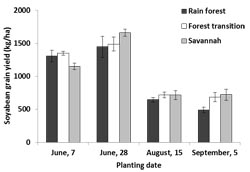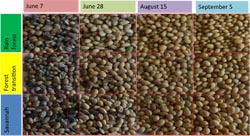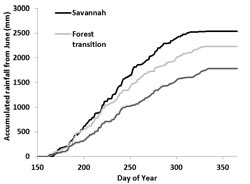In many regions where N2Africa works, farmers need to plant soyabean at the beginning of the growing season in order to have a mature crop by the time the rains cease. The humid tropics covering most of Sierra Leone and Liberia however are blessed with a rainy season of at least 7 months and a total annual rainfall often well over 2000 mm. Results from a planting date trial conducted in Sierra Leone in 2012 however indicated that the long growing season does not mean that farmers have a long window to plant soyabean. In fact, soyabean planting time is a crucial management factor that determines both the quantity and quality of harvested grains.
The soyabean trials in Sierra Leone showed that in all three agro-ecological zones, the rain forest, the forest transition and the savannah, highest grain yields were achieved with planting before August (Fig. 1). Planting in August or September gave an increased risk of drought stress towards the end of the growing period (November – December) (Fig. 2). Because of the photosensitivity of soyabean, late planting led to early flowering and a long grain-filling period, which further reduced yields. Early planting however was associated with increased fungal attacks on grains before and after harvest, which were worsened by poor post-harvest drying conditions. This led to a poor grain quality from soyabean planted in June (Fig. 3). Soyabean farmers are likely to face similar challenges with the drying of soyabean grain in the middle of the rainy season.
 |
Fig. 1 (top left): Soyabean grain yield as affected by planting time in three agro-ecological zones in Sierra Leone. Average of two varieties (TGx 1448-2E and TGx 1904-6F); error bars indicate standard errors of means Fig. 3 (bottom left): Pictures of grain from soyabean planted at different times in three agro-ecological zones in Sierra Leone Fig. 2 (bottom right): Accumulated rainfall from June 1 in three agro-ecological zones of Sierra Leone |
 |
 |
Given the trade-off between early planting providing high grain yields and late planting giving grains of a higher quality, the optimum planting period for soyabean is likely to be around mid July. This planting date will be an additional treatment when the trial is repeated coming season. The trial provided an important lesson about planting time that can be extended to groundnut. Groundnut farmers in Sierra Leone indicated that planting in May gives the highest yields, but the grain needs to be consumed or sold straight away and cannot be stored over a prolonged period. Groundnut planting in July gives a lower yield but the best grain quality, allowing farmers to use the grains as seed in the following season. Planting date is also likely to have an impact on the severity of aflatoxin infections, especially in groundnut. Late planting of groundnut could greatly reduce infestations, which are common in this environment and can cause severe health problems to humans and livestock.
Linus Franke, Keiwoma Mark Yila
